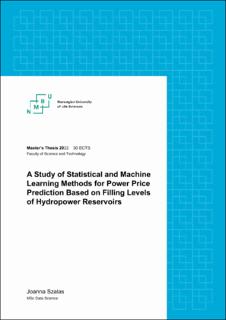| dc.description.abstract | The European power markets have become highly integrated over the past decade. The electrical grids of individual countries are increasingly well connected between each other, which allows for trading the electricity on the common markets and thus enhances the development of diverse electricity sources across the continent. With that comes an increasing volatility of the power prices. It is in the interest of all market players involved in generating, supplying, trading and consuming the electricity to find a way to forecast the power price as accurately as possible. This study investigates the potential of using filling level data from hydropower reservoirs and historical power price data - particularly, the Nordic system price - to forecast the future system price. For this purpose, three forecasting models for time series analysis were developed and evaluated - a statistical approach, as well as two artificial neural network architectures with different levels of complexity. The statistical approach is based on the autoregressive integrated moving-average model with exogenous inputs (ARIMAX), while the investigated neural networks include (a) a standard recurrent neural network (RNN), and (b) a combination of one-dimensional convolutional layers (1D CNNs) and a long short-term memory cell (LSTM). The experimental part of this work is based on data collected from 63 Norwegian hydropower reservoirs between 2015-2021. An extensive hyperparameter tuning was conducted on the machine learning models, including input data transformations, prediction time frames, network architecture parameters and the shape of the RNN/LSTM 3D input data tensor. The ARIMAX model outperformed the machine learning models for both most thoroughly tested prediction time frames of 14 and 28 days, achieving the R2 score of 0.8 and the MAE of 5.40 EUR. After a qualitative assessment of the obtained results it has been concluded that the models show some promising potential, however, a number of aspects would have to be further investigated to develop a mature solution, ready for practical use in, e.g. power trading. | en_US |

